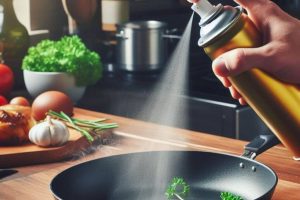What are the best substitutes for Non-Stick Cooking Spray?
Are you looking for healthy substitutes for non-stick cooking spray? Well, you’ve come to the right place! Say goodbye to those artificially flavored and chemical-filled sprays, and say hello to some natural substitutes that will take your meals to the next level.
In this article, we’ll explore the top alternatives to non-stick cooking sprays that not only promote better health but also enhance the flavor of your favorite dishes. From using high-quality oils like avocado or coconut to utilizing butter or oil and flour, we’ll cover it all. Prepare to elevate your cooking experience and wow your taste buds! And we will also look at ways to use non-food products as substitutes for cooking spray.
Whether you’re a seasoned home cook or just starting your culinary journey, this article will help you make informed choices and discover the best alternatives to non-stick cooking spray. Get ready to create healthier and more flavorful meals with these top picks!
Try using: Butter or Margarine, Cooking Oils, Shortening, Cooking Sprays with Different Oils, Parchment Paper, Silicone Baking Mats, Butter or Oil and Flour, Grease with the Food Itself, Cookware with Non-Stick Coating, Vegetable Purees.
What is Non-Stick Cooking Spray?
Non-stick cooking spray is a kitchen essential that’s been around for a while. It’s basically a cooking oil or a blend of oils that’s been processed into an aerosol spray. The idea behind it is to provide a convenient way to grease pans and cooking surfaces without using too much oil. This is especially handy for baking, grilling, and pan-frying, as it helps prevent food from sticking to the cookware. It’s a great alternative to using butter or traditional oils when you want to reduce the calorie content of your dishes.
Non-stick cooking spray is generally safe to use when used as directed, but there are a few things to keep in mind. It typically contains propellants and emulsifiers, which are safe for consumption in small quantities. However, if you overuse it or heat it to very high temperatures, it can release potentially harmful fumes, such as perfluorooctanoic acid (PFOA) if the spray contains PTFE (polytetrafluoroethylene). PFOA has been associated with health concerns.
To minimize any potential risks, it’s best to use non-stick cooking spray in a well-ventilated area, avoid overheating it, and to follow the manufacturer’s instructions. There are also alternative cooking sprays available, like those made with canola or coconut oil, which can be a healthier option. So, while non-stick cooking spray can be a useful tool in the kitchen, it’s a good idea to use it in moderation and with proper care to ensure your safety.
By making the switch to one of the alternatives we have listed here, you can avoid the potential risks associated with non-stick sprays, such as harmful chemicals and possible damage to your cookware. You’ll also have better control over the amount of oil or fat you use, resulting in healthier and more delicious meals.
Okay, before we look at your non-stick cooking spray substitute options, let’s deal with that empty cupboard situation!
Where can I buy Non-Stick Cooking Spray?
If you want to be more prepared and ensure you don’t run out of non-stick cooking spray, then you should stock up now.
Nowadays, general supermarkets stock a wide variety of non-stick cooking sprays. Or if you prefer you can also purchase non-stick cooking spray on-line.
So why not jump on and place your order today.
STOCK UP NOW!
Non-stick Cooking Spray – Organic
This Organic Extra Virgin Olive Oil comes in a non-propellent spray format. No nasty chemicals!
Easy to use and has a great natural taste.
Gluten-free, Non-GMO, USDA Certified Organic
What can I substitute for Non-stick Cooking Spray?
Here are some of the best ingredients to substitute the flavor and role that non-stick cooking spray provides in your recipes.
- Butter or Margarine
- Cooking Oils
- Shortening
- Cooking Sprays with Different Oils
- Parchment Paper
- Silicone Baking Mats
- Butter or Oil and Flour
- Grease with the Food Itself
- Cookware with Non-Stick Coating
- Vegetable Purees
Non-stick Cooking Spray substitutes
Butter or Margarine
Butter or margarine can be great replacements for non-stick spray.
- Use a stick of butter or a small amount of softened butter.
- Take a paper towel or a pastry brush and dip it into the softened butter.
- Grease your baking pan, skillet, or griddle by applying a thin, even layer of butter to the surface. Be sure to cover all areas where your food might come into contact.
- This method works well for baking, frying, and sautéing.
Both butter and margarine come with a high calorie count, so consider how much you are going to use, especially if you are also trying to be health conscious.
Remember that using butter or margarine imparts a delicious flavor to your dishes, which is an added bonus. However, it’s essential to watch the heat, as butter and margarine have lower smoke points than some cooking oils. Overheating them can lead to burning and off-flavors. So, adjust your cooking temperature accordingly, and you’ll have a tasty, non-stick result.
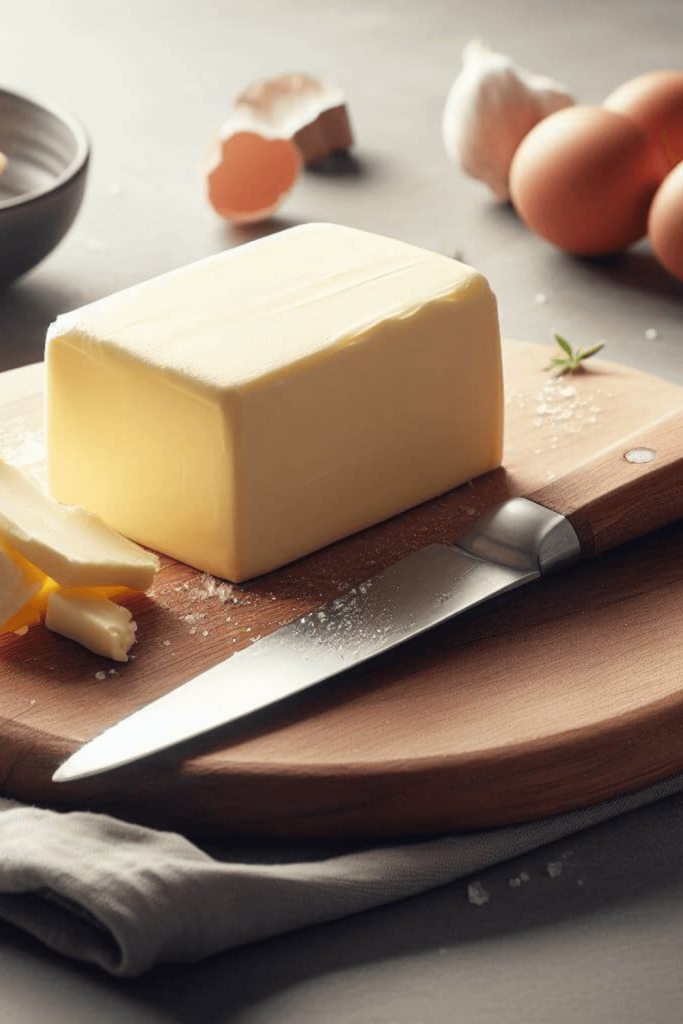
Cooking oils
Cooking oils can be a versatile and flavorful replacement for non-stick spray.
- Select a cooking oil that suits your recipe. Common options include vegetable oil, canola oil, olive oil, and coconut oil. The choice depends on the flavor profile you want to achieve.
- If you’re using a pan, skillet, or griddle, make sure it’s clean and dry. If it’s a baking dish, ensure it’s ready for your recipe.
- Using a pastry brush or a paper towel, apply a thin and even layer of the cooking oil to the surface. Make sure to cover the bottom and sides of the pan or dish.
- Ensure that the oil is spread evenly to create a non-stick barrier. Excess oil can lead to greasy results.
- Follow the recommended cooking times and temperatures in your recipe. The cooking oil will help your food release easily.
Using cooking oils not only provides non-stick properties but also adds a delicious flavor to your dishes. It’s a wonderful way to enhance the taste of your recipes.
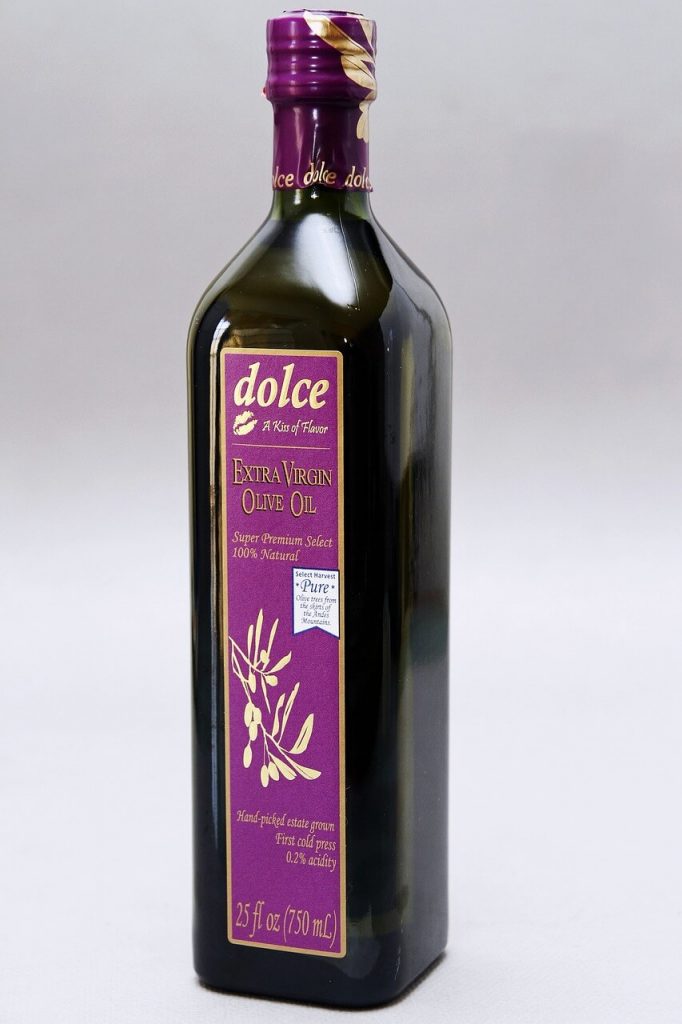
Shortening
Shortening is a type of fat that is typically made from hydrogenated vegetable oil. It’s solid at room temperature and is commonly used in baking and frying. Shortening can be used as a replacement for non-stick spray by following these steps:
- Ensure that your shortening is at room temperature, as this will make it easier to work with.
- Using a paper towel, pastry brush, or your fingers, take a small amount of shortening and spread it evenly on the cooking surface.
- Make sure to coat the entire surface, including the sides if needed.
- You can use shortening to grease cake pans, muffin tins, or cookie sheets.
- You can also use it to grease your hands when working with sticky dough or batter to prevent them from sticking.
- When frying foods in a pan, you can use shortening to prevent sticking. It’s especially good for recipes that require deep frying.
- Remember, shortening doesn’t add much flavor to your dishes, so it’s ideal for situations where you don’t want to introduce a strong taste like butter would.
One thing to note is that shortening has a higher smoke point compared to butter, so it’s less likely to burn at high temperatures. However, it’s not as commonly used as it once was due to health concerns related to hydrogenated oils. If health is a concern, you might consider using other alternatives with less saturated fat.
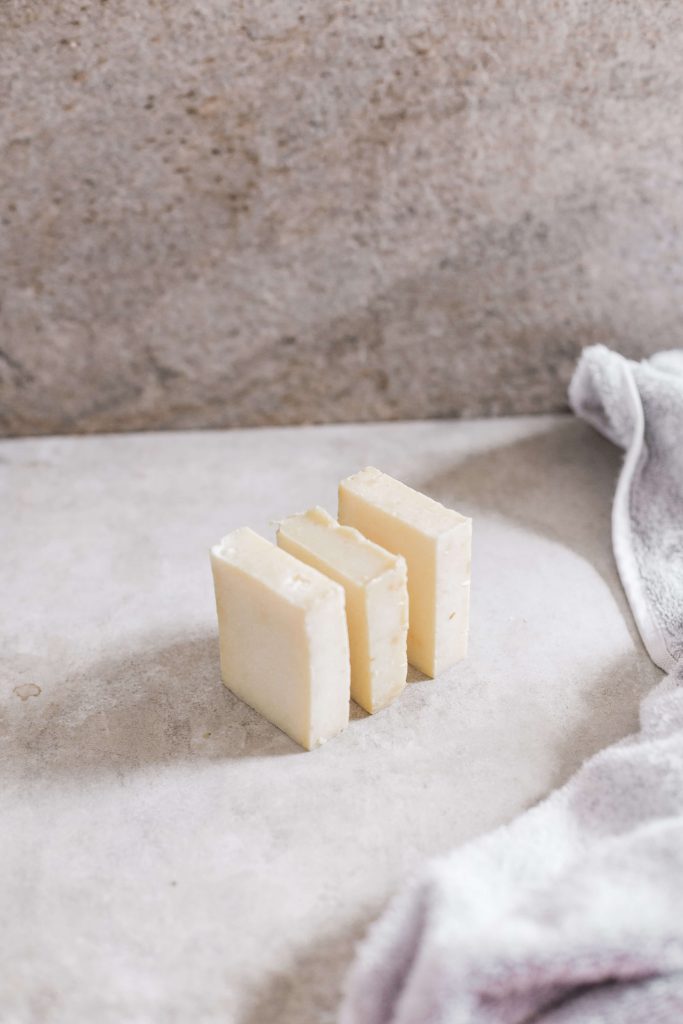
Cooking Sprays with Different Oils
Using cooking sprays with oils as a replacement for non-stick spray is simple and convenient. As mentioned in the ‘Buy Now’ section you can purchase cooking sprays both in aersol cans and non-propellent pumps.
- Before using the cooking spray, give the can or bottle a good shake to ensure that the oil is well-mixed.
- When spraying, hold the can or bottle upright, about 6-12 inches away from the surface you want to grease.
- Apply a light, even coat of the cooking spray to the entire surface of your pan, baking dish, or griddle. Make sure to cover all areas where your food might come into contact.
- Remember to read the label on the cooking spray can or bottle as some sprays are specifically designed for high-heat cooking, while others are meant for lower temperatures. Use the appropriate spray for your cooking method.
- Cooking sprays with oils are versatile and can be used in baking, frying, sautéing, and grilling, just like non-stick spray.
- Don’t go overboard with the spray. A little goes a long way, and excessive use can make your dishes greasy.
- After using, store the can or bottle in a cool, dry place away from direct heat or sunlight.
Using cooking sprays with oils is a convenient way to ensure that your food doesn’t stick to the cooking surface. It’s especially useful in recipes where you want to add additional flavors. Coconut or avocado oils are extremely popular. Some tasty and flavorful substitutes for cooking spray!
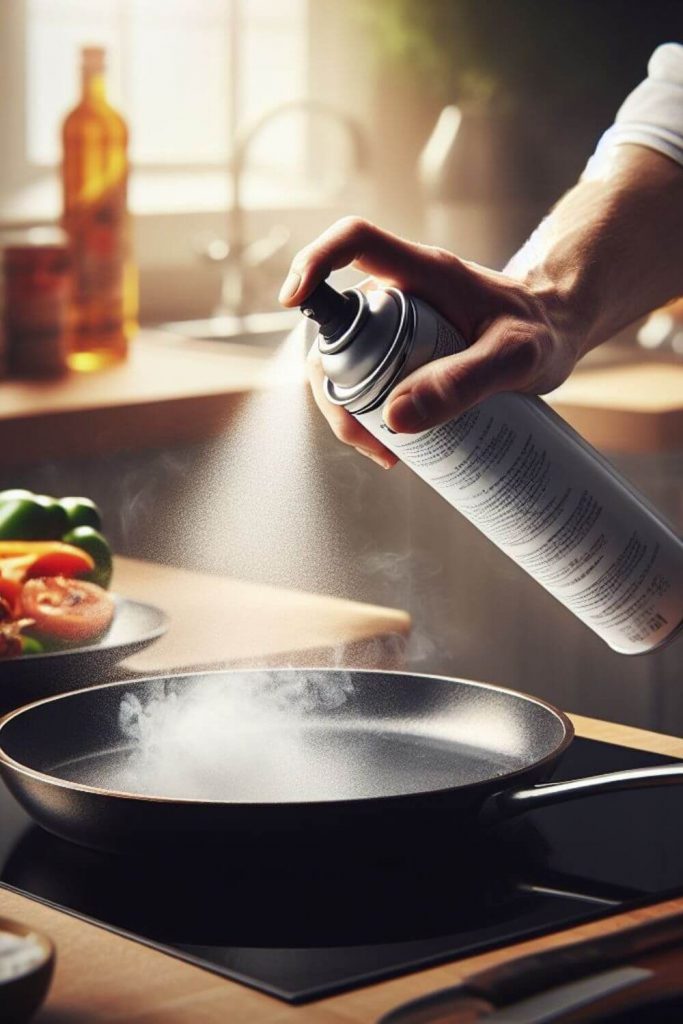
Parchment Paper
Using parchment paper as a replacement for non-stick spray is a breeze, and it’s a fantastic option for baking.
- Preheat your oven to the temperature specified in your recipe.
- Cut a sheet of parchment paper to fit the bottom of your baking pan or sheet. You can do this by tracing the bottom of the pan and then cutting along the lines.
- Place the cut parchment paper in the pan or on the baking sheet. It should lay flat and cover the entire bottom.
- Continue with your recipe as usual, whether you’re making cookies, brownies, or a cake. There’s no need to adjust the recipe; just follow the instructions.
- When your dish is ready for baking, just pop it in the preheated oven. The parchment paper will prevent sticking, and your baked goods will come out easily.
- Once your dish is done baking, let it cool for a bit. When it’s cool to the touch, you can easily lift it out of the pan by grabbing the edges of the parchment paper. It should come away cleanly.
Parchment paper is a fantastic handy non-stick solution that also simplifies cleanup since there’s no need to scrub your baking pans. Just be sure not to use it on open flames or direct contact with the broiler, as it can scorch at high temperatures.
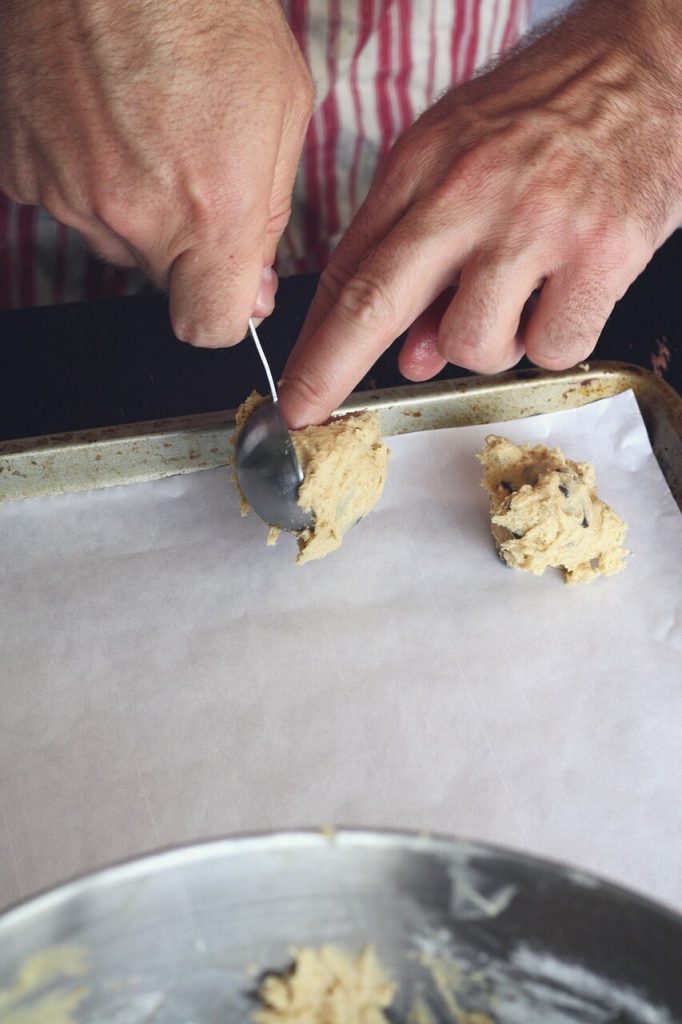
Silicone Baking Mats
Using silicone baking mats as a replacement for non-stick spray is a fantastic choice, especially for baking.
- Begin by preheating your oven to the temperature specified in your recipe.
- Lay the silicone baking mat flat on the baking sheet or pan that you plan to use. It should fit snugly within the pan.
- Follow your recipe as usual, whether it’s for cookies, pastries, or anything else you’re baking. There is no need to adjust your recipe; just simply proceed with the instructions.
- When your dish is ready for baking, place the baking sheet with the silicone mat into the preheated oven.
- As your dish bakes, the silicone mat will prevent sticking, and your baked goods will come out easily. Once your baking is done, remove the mat with your treats still on it.
- Allow your baked goods to cool for a bit, and then you can easily lift them off the silicone mat. The mat can be wiped clean with a damp cloth or washed in the sink, making cleanup a breeze.
Silicone baking mats are not only a non-stick solution but also an eco-friendly and reusable alternative to parchment paper.
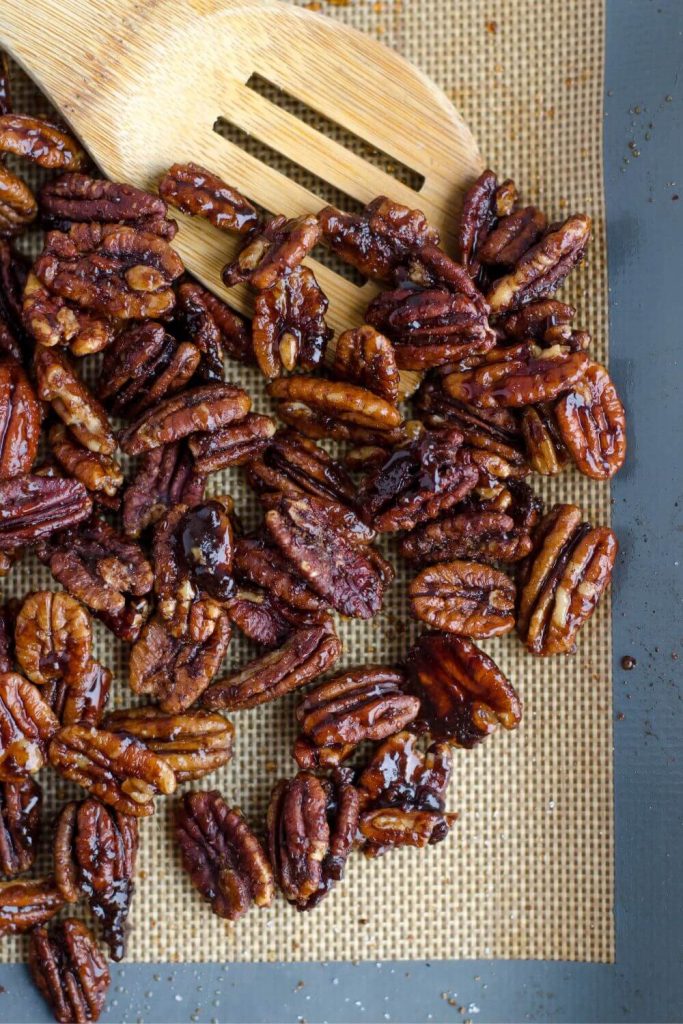
Butter or Oil and Flour
Using a combination of butter or oil and flour as a replacement for non-stick spray is a traditional and effective method, especially for baking.
- Start by ensuring your baking pan or dish is clean and dry.
- Take a small amount of softened butter or cooking oil (like vegetable or canola oil) and use a paper towel or pastry brush to evenly coat the interior surface of your pan. Make sure to cover the bottom and sides.
- After greasing, sprinkle a small amount of all-purpose flour evenly over the oiled surface. You can do this by adding a spoonful of flour and then gently shaking and tilting the pan to spread it around.
- Hold the pan sideways or upside down and tap it lightly to remove any excess flour. You want a thin, even layer that sticks to the greased surface.
- Continue with your recipe as usual, pouring your batter or ingredients into the prepared pan.
- Your dish will bake without sticking to the pan. The combination of the greased surface and flour creates a non-stick barrier.
- After baking, let your dish cool for a bit. You can then use a spatula or your hands to gently release the baked goods from the pan.
This method works well for a variety of baked goods, from cakes to bread, and it’s an excellent way to ensure easy removal without relying on non-stick sprays.
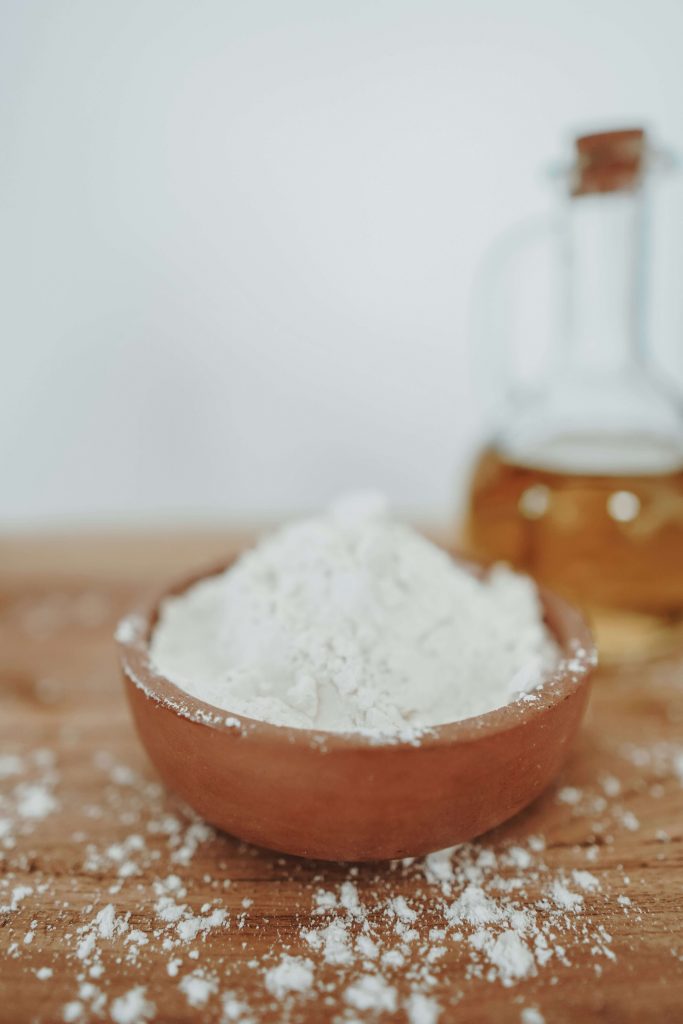
Grease with the Food Itself
Using the food itself to grease your cooking surface can be a practical and flavorful way to replace non-stick spray, especially when grilling or pan-frying certain foods.
- This method works best with foods that naturally release oils when cooked, such as fatty cuts of meat, fish with skin, or vegetables with a high water content.
- Make sure your grill, skillet, or pan is preheated to the desired temperature.
- Season your food with your preferred seasonings, and if it’s meat or fish, make sure it’s at room temperature.
- When the cooking surface is hot, carefully place your food directly on it. The natural oils or fats from the food will start to render and act as a natural non-stick agent.
- As the food cooks, you’ll notice it releasing its natural oils or juices. These will help create a non-stick surface.
- To prevent sticking, gently lift or flip the food when it’s ready. You’ll find that it comes off easily without tearing.
- Continue cooking until your food reaches the desired level of doneness.
Using the food’s natural oils is a great way to enhance the flavor of your dishes while keeping them non-stick. It’s a technique often used in grilling, and it’s perfect when you want to showcase the delicious results.
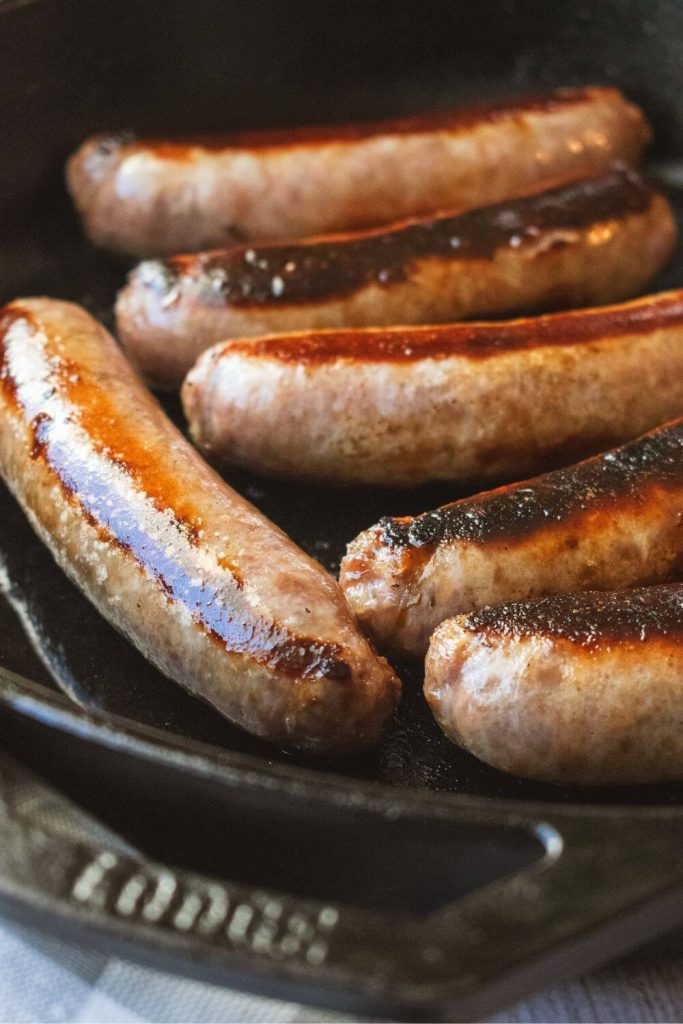
Cookware with Non-Stick Coating
Cookware with a non-stick coating is a convenient and effective replacement for non-stick spray.
Created back in the 1930s, it became a big hit with professional chefs. Today non-stick cookware is readily available to everyone. The best known is the brand Teflon. Teflon is actually a material called polytetrafluoroethylene (PTFE). It is a synthetic chemical made up of carbon and fluorine atoms. There were previous concerns regarding the safety of nonstick cookware but thanks to a federal ban, all Teflon and nonstick cookware made after 2013 should be free of the harmful PFOA chemical. Europe had previosuly enacted the same ban back in 2008.
- Whether it’s a non-stick frying pan, griddle, or baking sheet, preheat it to the temperature as specified in your recipe.
- Prepare your ingredients as directed in your recipe.
- When your non-stick cookware is hot, place your ingredients directly into it. The non-stick coating should prevent sticking without the need for additional grease.
- Follow the cooking instructions in your recipe, adjusting for the non-stick surface as needed. You’ll find that your food easily slides and releases from the cookware.
- Once you’re done cooking, the non-stick surface makes cleanup a breeze. Simply wash your cookware with warm, soapy water, and it should come clean easily.
Using non-stick cookware is an excellent way to reduce the need for added fats like non-stick spray or oils while ensuring your dishes don’t stick. It’s a fantastic choice, especially when you want to emphasize healthy and convenient cooking methods.
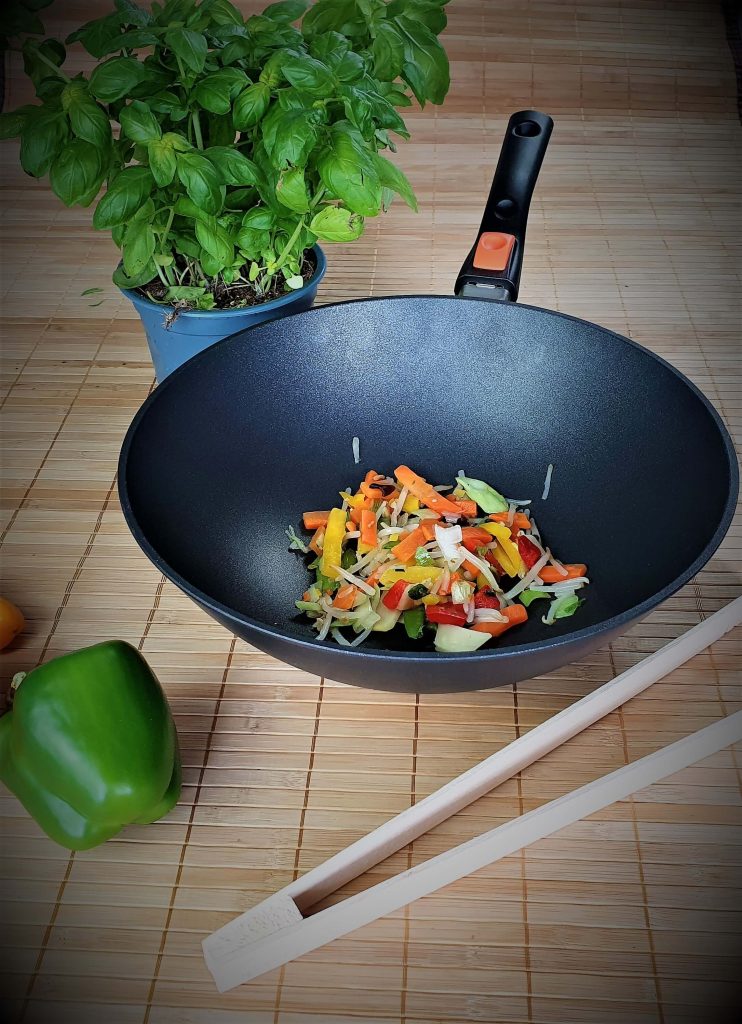
Vegetable Purees
Using vegetable purees as a replacement for non-stick spray is an interesting and healthier alternative, particularly in baking.
- Opt for purees that have a mild flavor and a moisture content, like applesauce, mashed bananas, or pumpkin puree. These work well in a variety of baked goods.
- Follow your baking recipe as usual, but with one imprtant adjustment: reduce the amount of fat (such as butter or oil) by half, since the puree will provide moisture and some non-stick properties.
- Incorporate the vegetable puree into your recipe at the point where you would typically add the fat. This can be during the creaming step for cookies or when mixing wet ingredients for cakes and muffins.
- Ensure that the puree is well-mixed into your batter or dough, so it’s evenly distributed.
- Continue with your recipe, following the baking instructions. The vegetable puree will help prevent sticking, especially in recipes that are prone to it.
- After baking, let your dish cool before removing it from the pan. You’ll find that it comes away easily due to the non-stick properties of the vegetable puree.
Using vegetable purees not only reduces the need for added fats but also adds a unique flavor and moisture to your baked goods. It’s a fantastic option to explore, particularly when you want to offer healthier alternatives in your recipes.
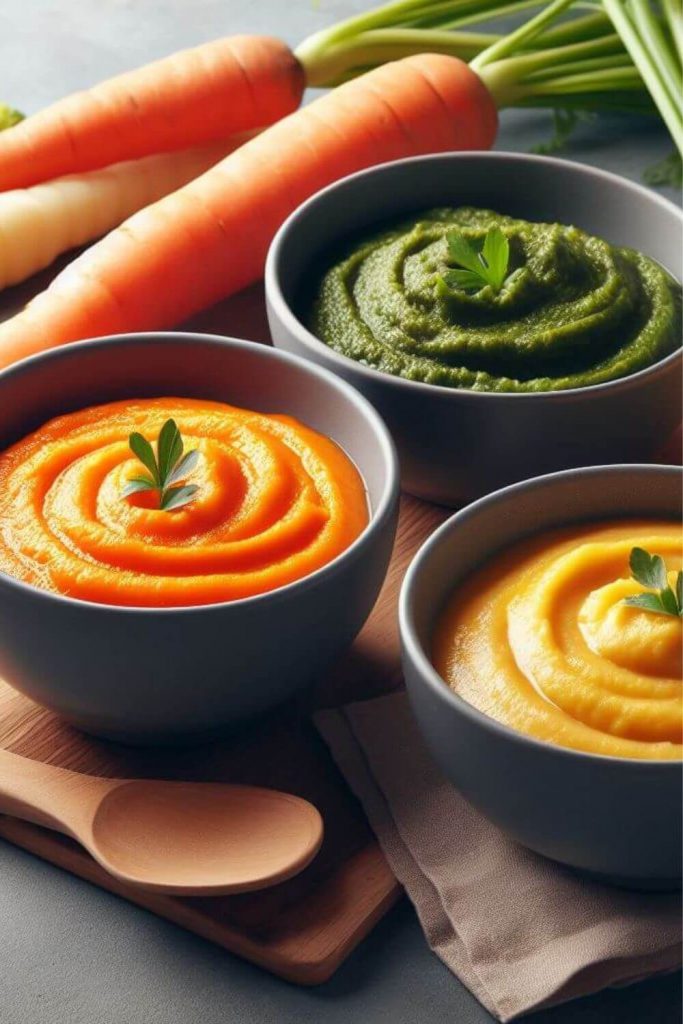
Summary for Non-stick Cooking Spray substitutes
Okay – that’s you all sorted with suitable substitutes for non-stick cooking spray.
Is there something on the list that interests you? Here’s a quick summary:
- Butter or Margarine: These can be applied in a thin layer to grease pans or baking dishes.
- Cooking Oils: Regular cooking oils like vegetable, canola, or coconut oil can be used to grease pans. You can apply them with a brush or paper towel.
- Shortening: Solid vegetable shortening like Crisco can work well for greasing pans, and it can handle high-heat cooking.
- Cooking Sprays with Different Oils: There are non-stick sprays made from different oils like canola or olive oil, which can be a healthier choice.
- Parchment Paper: Line your pans or baking sheets with parchment paper to prevent sticking, especially in baking.
- Silicone Baking Mats: These mats are excellent for baking, making cleanup easy, and keeping things non-stick.
- Butter or Oil and Flour: Grease your pans with butter or oil and then dust them with flour, which creates a non-stick surface.
- Grease with the Food Itself: Some recipes, like when grilling fish or meat, can benefit from lightly oiling the food directly.
- Cookware with Non-Stick Coating: Investing in quality non-stick cookware can reduce the need for additional sprays or greasing.
- Vegetable Purees: In baking, you can use things like applesauce, mashed bananas, or pumpkin puree as a non-stick alternative in some recipes.
Remember, the choice of substitute can depend on the specific dish and your dietary preferences. It’s all about finding the best fit for your recipe.
We have gathered together a lot more facts on ingredients such as herbs, spices, oils, nuts, etc. if you would like to learn some more.
Or if you need to swap out another ingredient have a look at our Substitutes section.
